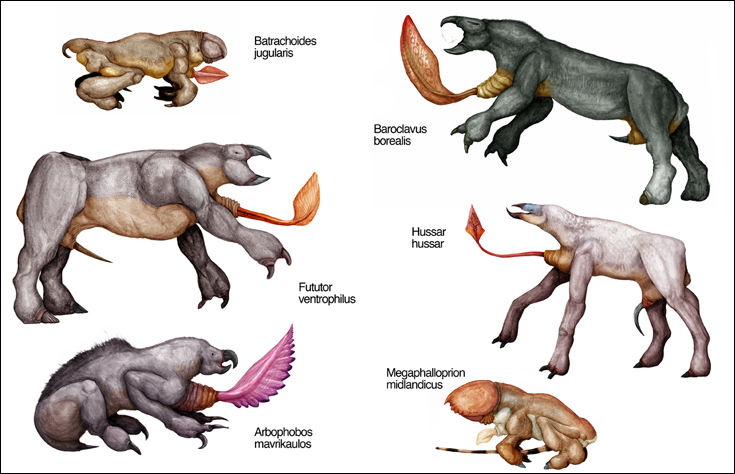Fututoriformes
To be politically correct, these predators are sometimes called “Catalchis,” “Humpers” or "Kuh." But every Snaiadi local knows them by their true name: to them, these animals are Fututors. Some know them by even less savoury names. The sight of a Fututor's weapon is enough to warrant its name. Connected directly to the pelvis, this is a knife-like structure that, when wielded by the hydraulic muscles on the animal's back, can inflict tremendous damage. The absence of genitalia or other vitally important organs in the pelvic region of Snaiad “vertebrates” has freed up this area for further evolutionary development and “humping” predatory habits or pelvic spikes have evolved more than once on Snaiad, among the primitive Turtiformes and snake-like Emmiformes. In most environments, the Fututoriformes compete for predatory niches with the equally well-armed Kahydroniformes. As a result of their anatomical specializations, Fututors usually fare better as precision-striking ambush hunters, while Kahydrons are more adept at chasing down prey over long distances.
Fututors are a comparatively recent group, appearing in the fossil record around the same time as Kahydronts, +- 22 million years ago. The evolution of these predatory guilds seems to have affected mainland faunas quite drastically, with a lot of “archaic” predators and some of the stranger herbivores disappearing within a short span of time.
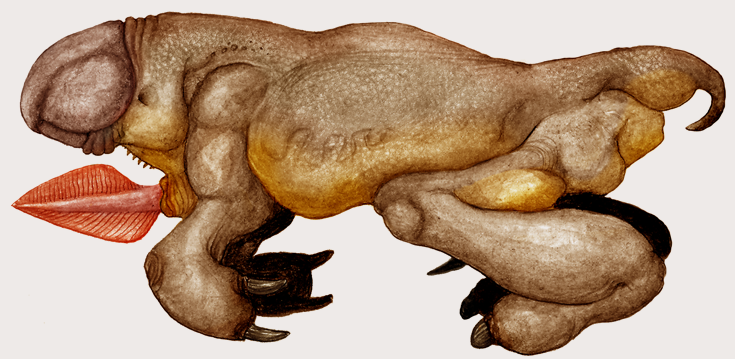
Species: Batrachoides jugularis
Common Name: Ifrig.
Size: 50-60 centimeters long.
Habitat: Jungles along the eastern seaboard of Vesterna.
Best described as midget Fututors, this family of small predators resembles oversized frogs with bad attitudes. Unlike earthly frogs however, Ifrigoid Fututoriformes have nothing to do with the amphibian lifestyle. They are fully terrestrial and warm-blooded, with active, albeit tuned-down metabolisms. The 30-odd species of Snaiad Ifrigs all share a similar lifestyle. Cleverly disguised, they lie in wait for prey to pass them by. Some species even use lure-like secondary heads to bait prey. In eventuality, all Ifrigs pounce on the victims and quickly kill them with savage jabs of their pelvic spikes. Although they were once thought to be ancestors of all other Fututors that lived alongside their descendants, we now know that the true ancestral Fututoriformes looked nothing like the Ifrigoids, and these beasts are as specialized as any other Fututor. It seems that millions of years ago on their evolutionary history, the line leading to true Fututors took off after big game while the Ifrigs specialized to stalk smaller victims.
The species seen here, Batrachoides jugularis, is a pretty ordinary Ifrig that lives in the Vesternan subcontinent.
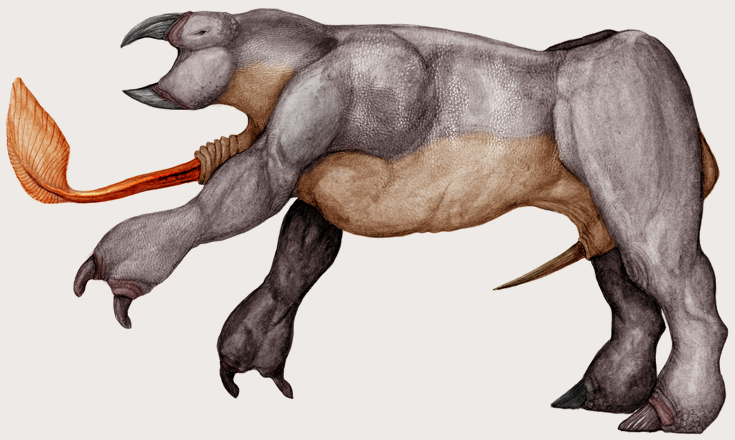
Species: Fututor ventrophilus
Common Names: Barrelchest, Missionary, Gray Paladin.
Size: More than 2.5 meters long, 1.5 meters at the shoulder.
Habitat: Pinnacle ranges, gallery forests and Erythrophyte scrubland in southern Vesterna.
Powerfully built, stealthy and vicious, Fututor ventrophilus is one of the more famous predators of Snaiad. These creatures spend most of their days sleeping in the shades, and become active only towards the afternoon. They creep silently towards their intended prey, or sometimes simply lie in wait, concealed in thick growth. When the attack comes, victims of F. ventrophilus are quickly overpowered and wrestled to the ground before being disemboweled by a quick thrust of its scimitar-like, elongated killing spike. The Fututors then withdraw and wait for their prey to expire, before cutting the carcass into edible bits with their sharp beaks. The sliced and diced meat is then grasped and swallowed by the creature’s long, flag-like secondary head. This organ brightly colored appendage also serves in social signaling, especially for warnings and mating displays.
Fututor ventrophilus and the closely related F. dominator range across most of mainland Snaiad. These two species belong to the Xiphioclavid group of slashing Fututors that are differentiated by their sword-like killing spikes and disemboweling predatory behavior. They usually tackle moderate-sized prey and avoid well-armored and/or gigantic herbivores to avoid damaging their specialized weaponry.
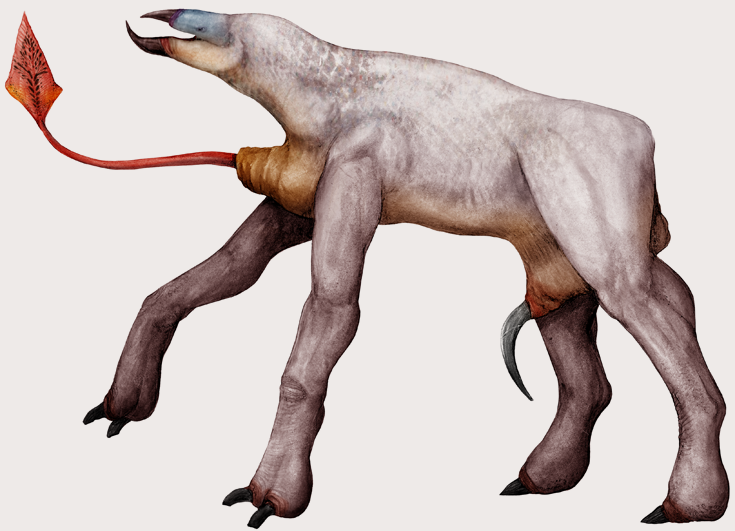
Species: Hussar hussar
Common Names: Hussar, Kukri, Pinnacle Hound.
Size: 130 centimeters long.
Habitat: All over Vesterna, and Western Isterna, usually common in pinnacle ranges.
This species, the only Xiphioclavid Fututoriform outside the genus Fututor, has specialized for a life in pinnacle ranges. Pinnacle ranges are a biome unique to Snaiad. They are characterized by open plains dotted regularly by vast, cathedral-like pinnacles; reef-like collections of symbiotic plants. In such an environment, normal plains-type grazers can live alongside island-like concentrations of isolated, jungle-type microhabitats. Hussar makes the best use of this situation, hiding and sheltering inside the pinnacles and hunting in the “gallery plains” around them. Their sword-like killing spike has an unusual kink, which helps it function as a climbing tool as well as a killing device. Dashing suddenly from the concealed outskirts of the pinnacle, it runs rapidly on its long, mare-like legs before tackling its prey in the usual Xiphioclavid fashion. After the prey expires, Hussar does not dissemble it on the spot, but carries it back to its home pinnacle. It climbs the massive, castle-like amalgam of trees with the aid of its kinked killing spike and devours its catch safe from the attention of larger predators.
Unlike most other large Fututoriformes, Hussar does not attack people and even approaches them with what could be described as a cautious curiosity. Nevertheless, visitors to Vesternian pinnacle ranges are discouraged from getting too close to these small, but formidably armed predators.
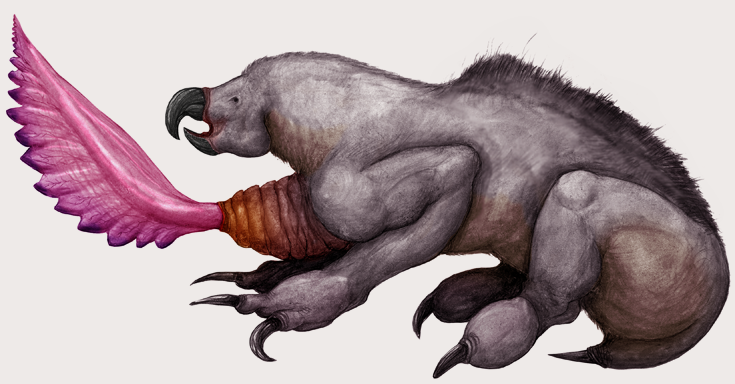
Species: Arbophobos mavrikaulos
Common Name: Mavri.
Size: More than 2 meters long.
Habitat: All of Isterna except for the Ankyranian desert. Also present on Oroland and eastern Vesterna.
While the Fututors seen before have specialized to slash their victims open with their sword-like killing spikes, (hence the name, Xiphioclavida,) the Baroclavids have solidly built, piton-like spikes that are adapted to deal with larger and tougher prey. Although its name suggests a tree-living existence, Arbophobos is a very adaptable hunter that lives in all manner of habitats, from Pinnacle ranges to dry scrubland, forests, jungles and sprogland. It usually hunts medium-sized animals like Xenosuids, Pneumagazelles and the like, but unlike other predators in its area it will readily tackle giant herbivores like Allotaurs if given the chance. These deadly creatures usually go for the giants’ bulging front legs, humping viciously in an attempt to penetrate the powerful hydraulic muscles that lie buried under thick layers of gristle, fat and muscle. The highly pressurized hydraulic fluid bursts in a sickening spray once the muscle jacket is pierced, and the Allotaur’s front limb goes limp for good. After the prey is immobilized, Arbophobos has the choice between killing it outright or waiting until the fight is gone out of the titanic herbivore. Unlike many other Snaiadi animals, Arbophobos and other Baroclavid Fututoriformes have a dense covering of body “hair” instead of subcutaneous air bubbles to keep them warm. It is theorized that this group traded off the “bubble wrap” system in order to become more nimble and maneuverable in their predatory pursuits.
Arbophobos used to be far more common around the Neomediterranean, where human settlement is mostly concentrated in Snaiad. Unlike many of their Snaiadi counterparts, these predators seemed to have no fear of people and killed countless settlers in the early years of colonization. A three-decade-long long series of “Arbophobe Wars” were fought with sonic irritators, chemical repellants, extensive fencing and even viral sterilization programs. However, the smart, pack-hunting animals always found a way around the defenses and inflicted painful losses to human colonists. As a final solution, Arbophobos was purposefully hunted to extinction around human settlements. This was one of the few cases where an indigenous species was intentionally persecuted due to the great risks it posed to people.
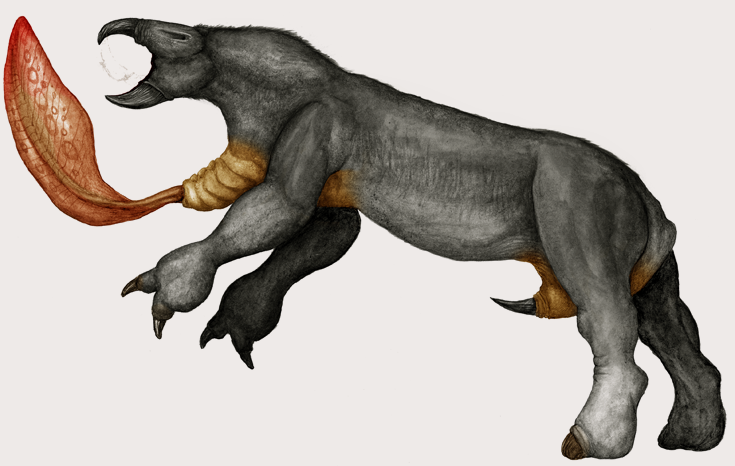
Species: Baroclavus borealis
Common Name: Black thing.
Size: Up to 4 meters long.
Habitat: North of the Sovan range on Isterna, including the Pontic forests and the northern tundra.
The largest Fututor on Snaiad is this giant Baroclavid that haunts the cold northern regions in Isterna. Unlike many other Fututoriformes, Baroclavus is more adapted for running than stalking and pouncing; with a more rigid backbone and legs of equal length. Like its Baroclavid relatives, it has a long shaggy coat that keeps it warm in the cold. Its giant size also helps it to conserve warmth in its Ifrigid environment. This magnificent beast of prey feeds almost exclusively on the equally imposing giant Forest Hadrons (Sylvihadron ponticus) that live in its territory.
Beyond these details, not much is known about behavior or lifestyle of Baroclavus. It has a very dispersed and apparently low population in a huge, impenetrable and little-explored territory, and is in any case probably dangerous to potential observers. Evidence gathered from robot cameras and stool samples indicates that this giant Fututor might supplement its diet with limited pickings of fruit or forest-floor sprog.
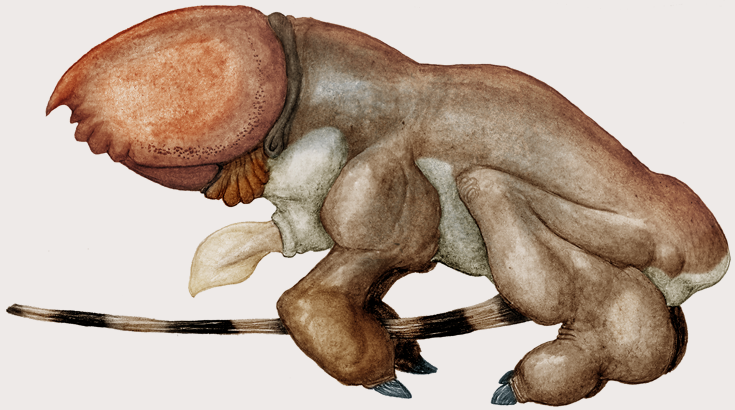
Species: Megaphalloprion midlandicus
Common Name: Flipstick.
Size: 20 centimeters long or less.
Habitat: Erythrophyte scrubland in Midland, relatives also present in Oroland.
The grotesquely proportioned Flipsticks are bizarre cousins of the Ifrigs and the Fututors that seem to have taken an evolutionary roller-coaster ride. Endemic to the recently isolated Midland, they all bear disproportionate killing spikes that are completely useless for hunting. In fact, these organs, which in some species can grow up to five times the body length of their owners, seem to serve no single obvious purpose. Some species use the spikes for “power jumps”, while in others it seems to serve as a sexual ornament, although both sexes have them. Experiments carried out with these creatures revealed that removing the disproportionate spikes actually helped them catch more food, so it is possible that the extra-long appendage is just a random consequence of evolution that simply hasn’t been selected against. Yet.
The Flipstick pictured here, M. midlandicus, has been observed drumming its spike on the ground, perhaps as a form of communication or warning. It has a bright red color that camouflages it perfectly among the red and orange Erythrophyte maquis it lives among. The 57 or so known species of Flipsticks mostly inhabit the Midland, although some seem to have been dispersed by rafting to Oroland and the shores of Isterna. All feed on small animals they kill with butts of their oversize beaks. Potent toxins carried in their bodies assure that no predator harms these puzzling and awkward animals.
Copyright laws protect all intellectual property associated with Snaiad.
All artwork, concepts and names associated with this project belong to C. M. Kosemen, unless otherwise stated.
